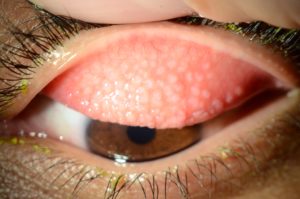Causes
Allergic reactions or contact lens materials, solutions or protein deposition on the contact lens; trauma; bacterial, viral or parasitic (e.g. acanthamoeba) corneal infections.
Risk Factors
Contact lens overwear, sleeping in contact lenses, showering or using hot tub in contact lenses, ocular trauma.
Complications
Corneal irregularity, corneal abrasion, corneal scarring, corneal thinning, corneal perforation, mild to severe decreased vision and rarely blindness.
Tests and Diagnosis
Slit lamp examination is essential. Corneal scrapings for smears and cultures may be indicated if a corneal infection is suspected.
Treatment
Depends on the specific diagnosis. Most require cessation of contact lens wear, at least temporarily. Problems from contact lens overwear or giant papillary conjunctivitis often improve with a contact lens holiday. Some patients may be able to resume contact lens wear, at which point we usually recommend daily disposable lenses. Corneal infections are treated with appropriate antibiotic, anti-fungal or anti-acanthamoeba medications.
Prevention
Appropriate contact lens wear, including no sleeping, showering, or swimming in contact lenses. Remove contact lenses whenever the eye is red or irritated and seek urgent ophthalmic care if the symptoms persist.

 Contact lenses, while safe and effective for the vast majority of people, can cause a variety eye problems. Some are not too dangerous, such as giant papillary conjunctivitis, while others are more serious, such as corneal abrasions, inflammation or infection. When these complications are diagnosed and treated promptly, the results are typically quite good. However, corneal ulceration and scarring can occur and cause temporary or permanent poor vision. Rarely, contact lens wearers can develop a parasitic infection called acanthamoeba, which can be devastating.
Contact lenses, while safe and effective for the vast majority of people, can cause a variety eye problems. Some are not too dangerous, such as giant papillary conjunctivitis, while others are more serious, such as corneal abrasions, inflammation or infection. When these complications are diagnosed and treated promptly, the results are typically quite good. However, corneal ulceration and scarring can occur and cause temporary or permanent poor vision. Rarely, contact lens wearers can develop a parasitic infection called acanthamoeba, which can be devastating.









